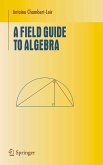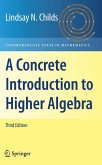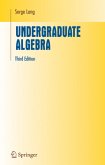This is a small book on algebra where the stress is laid on the structure of ?elds, hence its title. Youwillhearaboutequations,bothpolynomialanddi?erential,andabout the algebraic structure of their solutions. For example, it has been known for centuries how to explicitely solve polynomial equations of degree 2 (Baby- nians, many centuries ago), 3 (Scipione del Ferro, Tartaglia, Cardan, around th 1500a.d.), and even 4 (Cardan, Ferrari,xvi century), using only algebraic operations and radicals (nth roots). However, the case of degree 5 remained unsolved until Abel showed in 1826 that a general equation of degree 5 cannot be solved that way. Soon after that, Galois de?ned the group of a polynomial equation as the group of permutations of its roots (say, complex roots) that preserve all algebraicidentitieswithrationalcoe?cientssatis?edbytheseroots.Examples of such identities are given by the elementary symmetric polynomials, for it is well known that the coe?cients of a polynomial are (up to sign) elementary symmetric polynomials in the roots. In general, all relations are obtained by combining these, but sometimes there are new ones and the group of the equation is smaller than the whole permutation group. Galois understood how this symmetry group can be used to characterize the solvability of the equation. He de?ned the notion of solvable group and showed that if the group of the equation is solvable, then one can express its roots with radicals, and conversely.
From the reviews:
"This is a textbook for a second course in undergraduate abstract algebra. ... Along the way, certain very interesting results are covered that are not often seen in books at this level ... . includes numerous exercises which significantly extend material in the text."
(William M. McGovern, SIAM Review, Vol. 47 (2), 2005)
"The textbook focuses on the structure of fields and is intended for a second course in abstract algebra ... The reader will learn about equations, both polynomial and differential ... . In explaining these concepts, the author also provides ... leads the reader along many interesting paths. ... There are exercises at the end of each chapter, varying in degree from easy to difficult. ... author has incorporated pictures from the history of mathematics, including scans of mathematical stamps and pictures of mathematicians."
(Zentralblatt für Didaktik und Mathematik, February, 2005)
"This nice volume starts with constructions with ruler and compass and uses these old problems as a peg for field theory, especially for Galois Theory. ... it also deals with some mathematical pearls which one cannot find so easily in the textbooks and for which I like this text a lot ... . The whole manuscript is written very carefully and can be heartily recommended to students and to teachers as well."
(J. Schoissengeier, Monatshefte für Mathematik, Vol. 148 (4), 2006)
"The book can ... be described as a good second course in abstract algebra focusing on the structure of fields in general and field extensions in particular. ... There are many exercises ... most of them rather challenging. ... it is a well written text which is especially suitable for students about to study abstract algebra seriously."
(P. Shiu, The Mathematical Gazette, Vol. 90 (519), 2006)
"The distinctive features of Chambert-Loir's book are as follows: first, it develops many results that should give undergraduate mathematics majors immediate and substantial satisfaction ... second, the book concludes with a novel undergraduate-level introduction to the algebraic theory of differential equations. ... Summing Up: Highly Recommended. General Readers; upper-division undergraduates through professionals."
(D. V. Feldman, CHOICE, Vol. 42 (10), 2005)
"This book treats mainly Galois theory of finite extensions of fields. All the material necessary for such a study is presented in this book ... . There are a lot of exercises ... . A nice feature is the inclusion of portraits of mathematicians who made important contributions to the subject of this book."
(K. Kiyek, Mathematical Reviews, Issue 2005 h)
"This book is intended as a second course in algebra focusing mainly on Galois theory of the finite extensions of fields. ... The book is easy to read and mostly self-contained. The large number of exercises at different levels makes it a valuable source both as the basis for a course or self-study."
(G. Teschl, Internationale Mathematische Nachrichten, Issue 203, 2006)
"Toward advanced undergraduate students, the book focuses on those parts of abstract algebra which primarily deal with the structure of fields ... and the related algebraic theory of differential equations. ... the central theme of the text is field theory, together with its relations to some other areas in abstract algebra and to analysis. ... No doubt, this fairly unique introduction to some central aspects of modern abstract algebra and its applications is a highly welcome and valuable complement to ... literature in the field."
(Werner Kleinert, Zentralblatt MATH, Vol. 1155, 2009)
"This is a textbook for a second course in undergraduate abstract algebra. ... Along the way, certain very interesting results are covered that are not often seen in books at this level ... . includes numerous exercises which significantly extend material in the text."
(William M. McGovern, SIAM Review, Vol. 47 (2), 2005)
"The textbook focuses on the structure of fields and is intended for a second course in abstract algebra ... The reader will learn about equations, both polynomial and differential ... . In explaining these concepts, the author also provides ... leads the reader along many interesting paths. ... There are exercises at the end of each chapter, varying in degree from easy to difficult. ... author has incorporated pictures from the history of mathematics, including scans of mathematical stamps and pictures of mathematicians."
(Zentralblatt für Didaktik und Mathematik, February, 2005)
"This nice volume starts with constructions with ruler and compass and uses these old problems as a peg for field theory, especially for Galois Theory. ... it also deals with some mathematical pearls which one cannot find so easily in the textbooks and for which I like this text a lot ... . The whole manuscript is written very carefully and can be heartily recommended to students and to teachers as well."
(J. Schoissengeier, Monatshefte für Mathematik, Vol. 148 (4), 2006)
"The book can ... be described as a good second course in abstract algebra focusing on the structure of fields in general and field extensions in particular. ... There are many exercises ... most of them rather challenging. ... it is a well written text which is especially suitable for students about to study abstract algebra seriously."
(P. Shiu, The Mathematical Gazette, Vol. 90 (519), 2006)
"The distinctive features of Chambert-Loir's book are as follows: first, it develops many results that should give undergraduate mathematics majors immediate and substantial satisfaction ... second, the book concludes with a novel undergraduate-level introduction to the algebraic theory of differential equations. ... Summing Up: Highly Recommended. General Readers; upper-division undergraduates through professionals."
(D. V. Feldman, CHOICE, Vol. 42 (10), 2005)
"This book treats mainly Galois theory of finite extensions of fields. All the material necessary for such a study is presented in this book ... . There are a lot of exercises ... . A nice feature is the inclusion of portraits of mathematicians who made important contributions to the subject of this book."
(K. Kiyek, Mathematical Reviews, Issue 2005 h)
"This book is intended as a second course in algebra focusing mainly on Galois theory of the finite extensions of fields. ... The book is easy to read and mostly self-contained. The large number of exercises at different levels makes it a valuable source both as the basis for a course or self-study."
(G. Teschl, Internationale Mathematische Nachrichten, Issue 203, 2006)
"Toward advanced undergraduate students, the book focuses on those parts of abstract algebra which primarily deal with the structure of fields ... and the related algebraic theory of differential equations. ... the central theme of the text is field theory, together with its relations to some other areas in abstract algebra and to analysis. ... No doubt, this fairly unique introduction to some central aspects of modern abstract algebra and its applications is a highly welcome and valuable complement to ... literature in the field."
(Werner Kleinert, Zentralblatt MATH, Vol. 1155, 2009)








